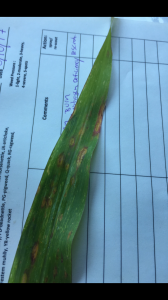At several of our farms we began to see some Northern Corn Leaf Blight in their fields and once our other clients caught wind of it, we were scouting full time for blight. Northern Corn Leaf Blight is identified by grey, cigar shaped lesions on the leaves of the corn plant and it generally shows up in the late season, from around the V12 stage and on. Due to the staggered planting this year because of the wet conditions, we did see some blight in corn that was younger, around the V8 stage. The majority of the blight that we saw was in fields that were no-till planted; the fungus is able to overwinter in the corn residue on the surface so in no-till applications it’s much more prevalent. When temperatures rise, the fungus become active and its spores are splashed up onto the leaves of the corn plant. It needs 6 to 18 hours of water on the leaf’s surface to infect the plant so during wet years like we’ve had this year or when the temperature cools and the dew takes longer to burn off, the fungus begins to be a problem.
Northern Corn Leaf Blight on left and Anthracnose Leaf Blight on right.
Another fungal disease we saw was Anthracnose leaf blight which is similar to Northern Corn Leaf Blight and causes similar foliar damage. Both fungal diseases cause the most damage when they’re seen in the crop during the period of two weeks before tasseling stage and the two weeks after tasseling stage.
The best way to control both of these diseases is to increase tillage practices to bury the stubble or plant resistant hybrids. The fungal disease is still seen in the resistant hybrids but the damage isn’t substantial and doesn’t cause any yields losses.
Nearing the end of my internship, I decided to continue to working with ACS during the semester throughout the rest of scouting season and harvest.


